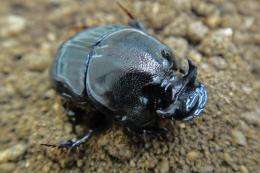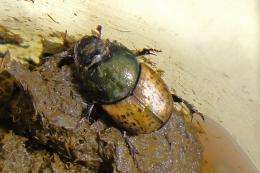Bubas bubalus adult
Specially chosen for their spring frenzy and voracious appetite for dung, two new species of European dung beetles have arrived in Australia to improve cattle pastures and finish off a job well started through more than 40 years of dung beetle work by CSIRO and partners.
Collected in the south of France, Onthophagus vacca and Bubas bubalus are the first new species of dung beetles imported in more than 20 years through a project led by CSIRO and supported by Meat and Livestock Australia (MLA).
“The beetles have just produced their first eggs in our quarantine facility,” according to CSIRO Ecosystem Sciences research leader Dr. Jane Wright.
“All going well, the offspring of these dung beetles will successfully bury the spring dung and improve pasture productivity in cattle producing regions of southern Australia,” Dr. Wright said.
Dung beetles use dung as a food supply for both adults and larvae. Most species build their nests with extensive tunnel systems, sometimes up to a metre deep beneath dung pads. At the ends of the tunnels are packed with fresh dung to form brood masses where eggs are laid.
Onthophagus vacca adult
Other species make dung balls which they roll away and then bury in the ground. From past introductions, 23 species of exotic dung beetles have become established in Australia.
“These beetles have been carefully selected for their suitability to the climate and seasons of southern Australia. We hope the new species will be the perfect allies for existing beetles that are doing a good job but are not active during the early spring months across southern Australia,” Dr. Wright said.
To try to fill this geographic and seasonal gap in dung beetle activity, researchers working out of CSIRO’s lab in Montpellier in southern France collected adult beetles of the two species and dispatched them to CSIRO’s Black Mountain Quarantine facility in Canberra where they are set up in breeding containers and their eggs are harvested.
“Once we have harvested the eggs they will be surface sterilised and ready for release from quarantine under AQIS supervision,” Dr. Wright said.
“We will place the eggs into man-made dung balls for development and synchronisation to the southern hemisphere season and then mass-rearing before the expected field release in 2014.”
“If the new beetles can become widely established the main benefit will be the head start they give to pasture productivity from early spring,” said Mr. Cameron Allan, the pasture production coordinator for MLA.
Some related benefits are likely to be improved soil aeration and root depth, less water run-off and nutrient loss, soil and greenhouse gas improvements from more nitrogen and carbon being stored for longer in the soil and the reduction in fly breeding sites and the numbers of bush flies.
Provided by CSIRO





















